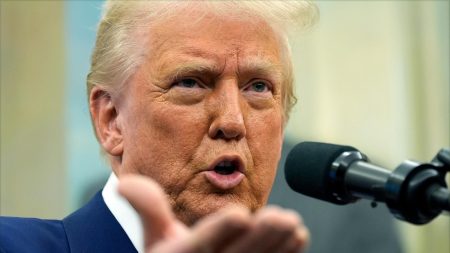The Escalating Trade Tensions Between the U.S. and China
A Brief Introduction to the U.S.-China Trade War
The trade tensions between the United States and China have reached a boiling point, with both nations imposing tit-for-tat tariffs on each other’s imports. On one side, U.S. President Donald Trump has announced plans to slap new duties on all steel and aluminum imports, while China has retaliated with its own set of tariffs on American goods. This recent escalation is reminiscent of the trade war that dominated much of Trump’s first term in office and continued under his successor, Joe Biden. The rapid exchange of tariffs and restrictions has raised concerns about the potential for a full-blown trade war, which could have far-reaching consequences for global markets and consumers alike.
A Historical Perspective on the U.S.-China Trade Conflict
The roots of the U.S.-China trade conflict can be traced back to Trump’s earliest days in office. In 2017, shortly after becoming president, Trump signed an executive order calling for stricter enforcement of tariffs in anti-dumping cases, signaling his intention to address the U.S. trade deficit with China. Later that year, during a visit to Beijing, Trump and Chinese President Xi Jinping agreed to a 100-day plan for trade talks aimed at reducing the U.S. trade deficit. However, these talks failed to yield significant results by July of that year.
The situation escalated further in 2018 when Trump launched an investigation into alleged Chinese theft of U.S. intellectual property, which the U.S. estimated was costing the country up to $600 billion annually. This was followed by the imposition of 30% tariffs on imported solar panels, primarily targeting Chinese imports. China responded with its own tariffs on U.S. goods worth about $3 billion, including fruits, nuts, wine, steel pipes, pork, and recycled aluminum. The U.S. then increased the stakes by imposing a 25% tax on Chinese goods from the aerospace, machinery, and medical industries, worth approximately $50 billion. China retaliated with 25% duties on U.S. imports such as aircraft, automobiles, soybeans, and chemicals, also worth around $50 billion.
Over the next few years, the two nations engaged in multiple rounds of tit-for-tat tariffs, affecting more than $250 billion worth of Chinese goods and over $110 billion worth of U.S. imports to China. These measures included 10% tariffs on $200 billion of Chinese goods, which were later increased to 25% in January 2019. Despite efforts to negotiate a trade deal, including a temporary halt on new tariffs in December 2018, the talks ultimately collapsed, leading Trump to raise tariffs on $200 billion worth of Chinese goods.
Recent Escalations in the Trade Conflict
In 2024, the trade tensions between the U.S. and China showed no signs of abating. Within less than a month of returning to the White House on January 20, Trump imposed 10% duties on all Chinese imports, a move expected to raise prices on a wide range of goods, including laptops, toys, and fast fashion. China wasted no time in responding, announcing 15% duties on coal and liquefied natural gas products, as well as a 10% tariff on crude oil, agricultural machinery, and large-engine cars imported from the U.S.
In addition to these tariffs, China took several other measures to retaliate against the U.S. Beijing launched an anti-monopoly investigation into Google and added PVH, the owner of U.S. fashion brands Tommy Hilfiger and Calvin Klein, to its "unreliable entity" list. Furthermore, China restricted the exports of five rare metals, which are critical components in the defense and clean energy industries, among others. These countermeasures underscore China’s determination to defend its economic interests and signal a potential escalation in the trade war.
The Impact on Industries and Global Trade
The ongoing trade war between the U.S. and China has had significant implications for various industries and global trade as a whole. The U.S. tariffs on Chinese goods have led to increased prices for consumers, particularly for electronics, apparel, and other imported products. Meanwhile, China’s retaliatory measures have targeted key U.S. industries such as agriculture, energy, and technology. The restrictions on rare metal exports, for instance, could have a profound impact on the global supply chain, particularly for industries reliant on these materials for advanced manufacturing and clean energy technologies.
The trade war has also raised concerns about the long-term effects on international trade relations. The imposition of tariffs and other trade barriers has disrupted global supply chains, led to increased costs for businesses, and created uncertainty for investors. While both nations have attempted to negotiate trade deals, such as the Phase One trade deal signed in 2020, these agreements have often fallen short of addressing the underlying issues. For example, the Phase One deal required China to purchase an additional $200 billion worth of U.S. goods and services over two years, but a research group later found that China had failed to meet this commitment.
The Role of the Biden Administration in the Trade Conflict
The trade policies of the Biden administration have also played a significant role in the ongoing tensions with China. Despite campaigning on a platform of reversing some of Trump’s more contentious policies, Biden has largely maintained the tariffs imposed by his predecessor. In fact, the Biden administration has introduced new restrictions, such as sweeping bans on the sale of semiconductors and chipmaking equipment to China. These measures have been expanded in recent years, with further restrictions implemented in October 2023 and December 2024.
In addition to these restrictions, Biden has raised tariffs on a range of Chinese products, including electric vehicles, solar cells, steel, aluminum, and medical equipment. These moves have been seen as an effort to protect U.S. industries and address concerns over China’s unfair trade practices. However, they have also drawn criticism from some quarters, with arguments that the tariffs are harming American consumers and businesses that rely on Chinese imports.
The Uncertain Future of U.S.-China Trade Relations
As the trade tensions between the U.S. and China continue to escalate, the future of their trade relations remains uncertain. The recent imposition of tariffs and other trade barriers by both nations has raised the stakes, with the potential for further retaliation and escalation. The situation is further complicated by the broader geopolitical tensions between the two powers, including issues related to security, technology, and regional influence.
Looking ahead, it remains to be seen whether the U.S. and China can find a path towards resolving their trade differences. While there have been intermittent efforts to restart trade talks, such as the phone call between Trump and Xi in 2019, these discussions have often been derailed by conflicting priorities and a lack of trust. The outcome of the 2024 U.S. presidential election could also play a significant role in shaping the future of U.S.-China trade relations, particularly if Trump follows through on his campaign promise to impose tariffs of at least 60% on all Chinese imports if he wins a second term.
In the meantime, businesses and consumers around the world will continue to feel the effects of the trade war, as increased costs, supply chain disruptions, and economic uncertainty become the new normal. While there is still hope for a resolution, the current trajectory of the U.S.-China trade conflict suggests that the road ahead will be fraught with challenges.















